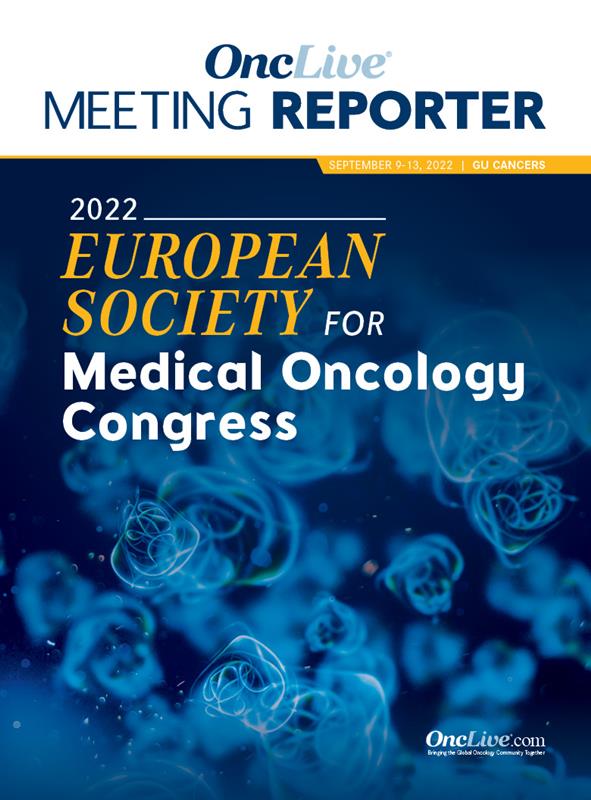Publication
Article
Supplements and Featured Publications
Cabozantinib Improves PFS Outcomes With Nivolumab, Ipilimumab in Advanced RCC
Author(s):
The triplet regimen of cabozantinib plus standard-of-care nivolumab and ipilimumab reduced the risk of disease progression or death by 27% vs placebo in patients with advanced renal cell carcinoma.
Toni Choueiri, MD

The triplet regimen of cabozantinib (Cabometyx) plus standard-of-care nivolumab (Opdivo) and ipilimumab (Yervoy) reduced the risk of disease progression or death by 27% vs placebo in patients with advanced renal cell carcinoma (RCC).
Data from the phase 3 COSMIC-313 trial (NCT03937219) showed that the median progression-free survival (PFS) with cabozantinib plus nivolumab/ipilimumab (n = 276) was not reached (95% CI, 14.0-not evaluable [NE]) vs 11.3 months (95% CI, 7.7-18.2) with placebo (n = 274; HR, 0.73; 95% CI, 0.57-0.94; P = .013). The 12-month PFS rates were 57% vs 49%, respectively.
Moreover, the objective response rate (ORR) with the addition of cabozantinib was 43% (95% CI, 37.2%-49.2%), compared with 36% (95% CI, 30.1%-41.8%) with placebo.
Data were presented by Toni Choueiri, MD, in a press briefing during the Congress. Choueiri is director of the Lank Center for Genitourinary Oncology, medical director of International Strategic Initiatives, and Jerome and Nancy Kohlberg Professor of Medicine at Harvard Medical School at Dana-Farber Cancer Institute in Boston, Massachusetts.
When stratified by intermediate (75%) and poor risk (25%), the PFS benefit was greater with cabozantinib plus nivolumab and ipilimumab in the IMDC intermediate-risk group. In the intermediate-risk subgroup, median PFS was not reached (95% CI, 16.9-NE) with the triplet, compared with 11.4 months (95% CI, 7.6-17.3) with placebo, reducing the risk for disease progression by 37% (HR, 0.37; 95% CI, 0.47-0.85). The ORRs with cabozantinib vs placebo in those with intermediate-risk disease were 45% (95% CI, 38.1%-52.0%) and 35% (95% CI, 28.6%-42.0%), respectively.
In those with poor-risk disease, the median PFS was 9.5 months (95% CI, 7.8-17.3) with cabozantinib plus nivolumab and ipilimumab, vs 11.2 months (95% CI, 4.0-NE) with placebo (HR, 1.04; 95% CI, 0.65-1.69). The ORRs with cabozantinib vs placebo were 37% (95% CI, 25.8%-50.0%) and 38% (95% CI, 26.2%-50.7%), respectively.
Choueiri noted that the safety profile of cabozantinib plus nivolumab and ipilimumab was generally manageable and consistent with the profiles of each respective therapy component. However, adverse events (AEs), which included elevated liver transaminases, diarrhea, and skin toxicity, occurred more frequently with the triplet regimen. Overall, grade 3/4 treatment-related AEs (TRAEs) occurred in 73% and 41% of patients in the cabozantinib and placebo arms, respectively. Each arm had 3 patients (1%) with grade 5 TRAEs, while 12% and 5% of patients, respectively, discontinued treatment due to TRAEs.
“COSMIC-313 is the first study that reported successful treatment intensification by the use of triplet therapy in [metastatic] RCC: The study team and participants should be congratulated for study conduct,” Viktor Grünwald, MD, PhD, University Hospital Essen, West-German Cancer Center Essen, Germany, said in a news release commenting on the data. “The addition of cabozantinib to ipilimumab plus nivolumab improved the weak spot of the ipilimumab/nivolumab doublet, which is early progression. However, treatment intensification is rarely seen without additional risks. Patients experienced the benefit of superior disease control, but also additional toxicities, treatment pauses and discontinuations.”
In the global, double-blind, randomized phase 3 trial, patients were randomized to receive either 40 mg cabozantinib once daily or matched placebo. All patients received 3 mg/kg nivolumab IV every 3 weeks plus 1 mg/kg ipilimumab IV every 3 weeks for 4 cycles, followed by either cabozantinib dose or placebo plus 480 mg nivolumab every 4 weeks, which was administered for up to 2 years. No crossover was allowed in the trial.
From June 2019 to March 2021, 855 patients were randomized to either the cabozantinib (n = 428) or placebo (n = 427) arms.
PFS per RECIST 1.1 by blind independent radiology review committee in the first 550 randomized patients served as the primary end point. Secondary end points included overall survival in the intention-to-treat population, ORR, duration of response, and safety.
To be eligible for the trial, patients could have no prior systemic therapy, a clear cell component to their disease, and intermediate to poor risk per IMDC criteria.
To conclude, Choueiri noted that follow-up for OS is ongoing.
“Despite in COSMIC-313 the triplet ipilimumab/nivolumab/cabozantinib yielded superior PFS when compared with the doublet ipilimumab/nivolumab, no OS data were reported,” Grünwald added. “The triplet may compete in the clinical landscape with recommended life-prolonging immune doublets but mature OS data is needed to become a novel standard of care.”
Reference
Choueiri TK, Powles TB, Albiges L. et al. Phase 3 study of cabozantinib (C) in combination with nivolumab (N) and ipilimumab (I) in previously untreated advanced renal cell carcinoma (aRCC) of IMDC intermediate or poor risk (COSMIC-313) Ann Oncol. 2022;33(suppl 7):S808-S869. doi:10.1016/annonc/annonc1089










